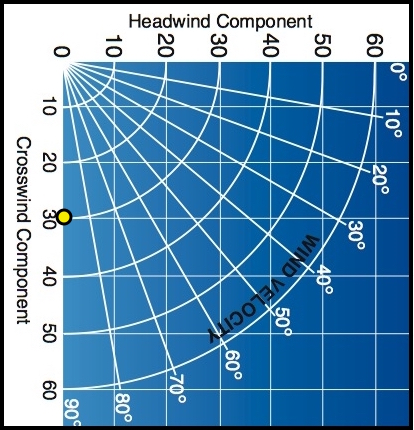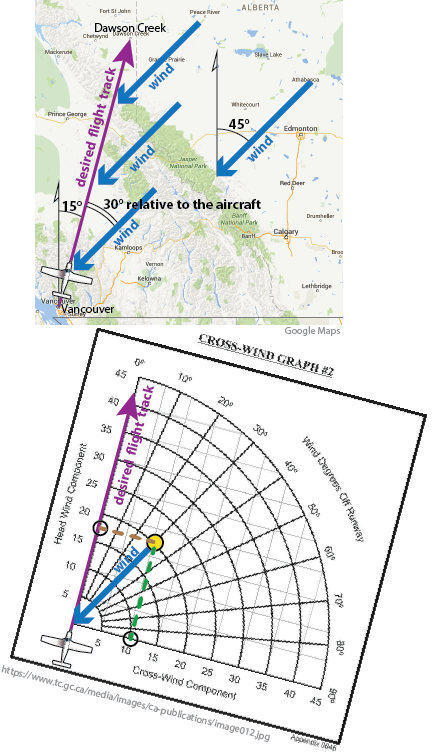ATSC 113 Weather for Sailing, Flying & Snow Sports
Crosswinds vs. Headwinds
Learning Goal 2d. Compute crosswind & headwind components
If you are a pilot or a sailor or a ski jumper, you are often concerned with how much wind is in your face (slowing you down) and how much wind is coming from the side (blowing you off track). So these winds are RELATIVE to the direction you are facing (relative to your ground track or course).
A wind directly in your face that slows you down is called a headwind. A wind from directly behind you is called a tailwind. Tailwinds are often good during most of the trip, because you can go faster, allowing you to get to your destination sooner (and with less fuel if in an airplane, motorboat, or snowmobile). However, for aircraft on an airport runway, tailwinds are bad because the aircraft needs more runway to take off and to land. For now, we consider tailwinds to be negative headwinds.
A wind from the side is called a crosswind.
Winds from both the right and left are called crosswinds. In aircraft
in flight, cross winds are easy to compensate for by "crabbing" (where
the aircraft is flying partly sideways relative to its track over the
ground, see Figure below). However, during
take-off and landings, crosswinds are difficult.
Many light aircraft have a max allowable crosswind component that is
approximately 15 to 20 knots (the exact number differs for each
aircraft, and is provided in the aircraft instruction manual) for take-off and landing.
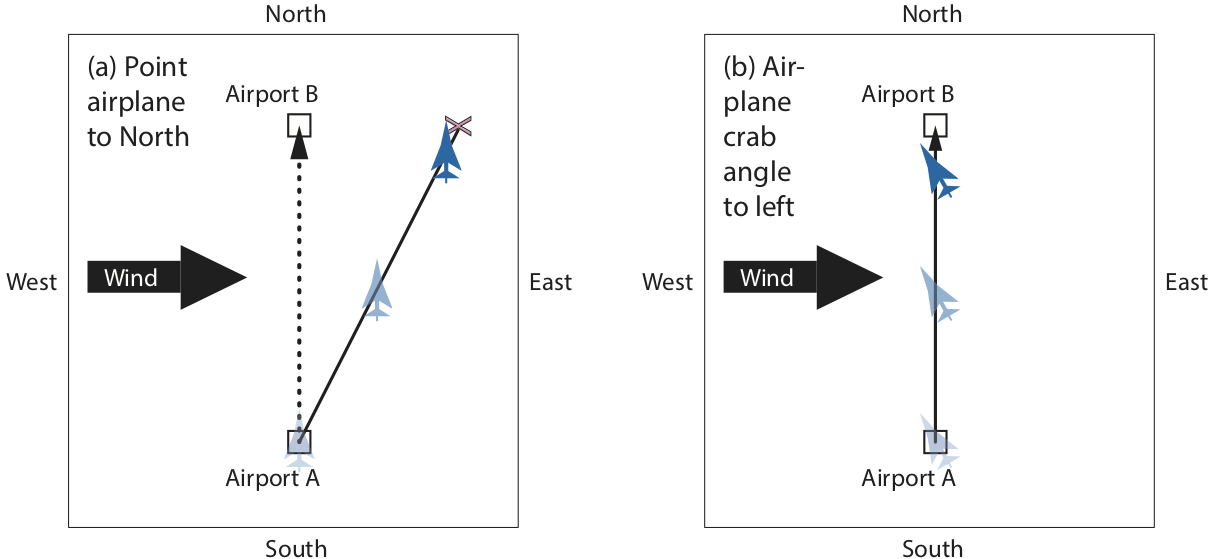
(a) Without crab. Suppose you want to fly the blue airplane
along the dotted track from Airport A to Airport B. Since B is
directly north of A, you fly a northbound heading (namely, you point
the airplane nose toward the north). But on this day, the wind is from
the west. The wind blows you off course toward the east, causing
you to end at location "X" instead of Airport B.
(b) With crab. Same airport and wind scenario as in (a), but this
time you point your aircraft nose towards the northwest. As you
fly northwest through the air, the air (with your airplane in it) moves
to the east. The net result is that your airplane moves along the
desired ground track from airport A to B. The plane seems to move
partially sideways relative to the ground track, similar to a crab
walking sideways. The crab angle is the angle between the ground
track and the direction the nose of the aircraft is pointed.
Fun video showing difficult Crosswind Landing in the Bahamas
The video linked below shows the joys of flying a Cessna Caravan (single engine turboprop aircraft) in the Bahama Islands. (This is the same type aircraft that was in Module C.) Although the video includes the whole flight including take-off and landing, you can skip ahead to time 12:30 into the video to see the approach and landing in a 25 knot crosswind. Notice the extreme movements of the control yoke (steering wheel) that the pilot is making during the approach and landing, in order to compensate for the crosswind and for turbulence. Landings in a strong crosswind are difficult.
Often, the actual winds not exactly straight on to your track and not perfectly across your track. So the wind partly slows you down (or speeds you up) and partly blows you off track. Namely, the actual wind has both a headwind component and a crosswind component RELATIVE to your track or course.
How do you find those components? Although you can figure it out using trigonometry, most people prefer to use a graph.

— Source: FAA Safety
This crosswind graph has the following componets:
- The curved lines represent the actual (total) wind speeds. The speed can be in any units (knots, mph, km/h).
- Diagonal straight lines represent the wind directions relative to your face (relative to the direction your aircraft is pointed).
- The vertical lines are the crosswind component in the same speed units as the actual wind.
- The horizontal lines are the headwind component also in the same speed units.
The procedure is to first plot a point on the graph corresponding to the actual (total) wind speed and direction RELATIVE TO THE DIRECTION YOU ARE FACING, and then use that point to read off the corresponding crosswind and headwind components.
HINT: You should conceptually rotate this whole chart until its vertial axis (the one labeled "headwind") is aligned in the direction that the aircraft is pointing. Namely, headwinds and crosswinds are always RELATIVE to the aircraft, not relative to compass directions for the Earth. You can think of the origin (point "0" in the lower left corner of the graph above) as representation the location of the aircraft.
Although the graph above focuses on headwinds and crosswinds, here
is a link to a similar graph
that includes both headwinds and tailwinds, along with the crosswind
component.
You would use it the same way as described in the examples below, and
it should give the same answer as the graph above. This graphical
tool is from the US FAA Aeronautical Info Manual (AIM).
The next subsections give Tips and Examples on how to use and compute
crosswinds and head/tail-winds.
Tips
Because crosswinds and headwinds are RELATIVE to the direction the aircraft is pointed, here are some situations where you know the direction the aircraft is pointed:- The aircraft orientation is given to you, in the statement of the problem.
- The aircraft is flying from landmark A to landmark B, where the landmarks might be (towns, lakes, navigation aides, etc.). Look on a map and draw a line from landmarks A to B. The direction of this line relative to North is the (approximate) direction the aircraft is pointed.
- The aircraft is approaching, landing or taking-off from a known runway. Runways are labeled by their compass direction. See more info in the next subsection.
Airports, Winds, and Runway Orientation
Aircraft try to land and takeoff into the wind (i.e., a headwind)
because they don't need so much runway length.
Runways are labeled by the magnetic compass direction toward which
aircraft are pointed when on (or approaching) the runway (see example
below). But that label is the number of degrees divided by 10.
For example, a runway pointing toward the east would have
the numbers 09 written on it (where 09 means 090 degrees).
Another example: if there is a runway oriented toward the
southeast, then
the approach end (the end of the runway first encountered by landing
aircraft) is labeled by that direction (rounded to the nearest tens of
degrees). A runway pointing toward the southeast would have the
numbers 14 written on it (14 means 140 degrees, which is 135 degrees
rounded to the nearest ten degrees).
Bottom line: pilots try to land and take off on a runway that has a
number closest to the wind direction number (rounded to nearest 10
degrees) because that gives the best headwind.
Solved Example: In the figure below, if aircraft are approaching runway
30 to land at CYVR Airport, then: (a) What direction is the aircraft
flying (what is its ground course)? (b) What is the wind direction if
the wind is straight down the runway?
Answer: (a) An aircraft flying toward CYVR from the southeast to land
on runway 30 would be flying on a course of 300°; namely flying TOWARD
the northwest. (b) The wind would be FROM 300°; namely, from the
northwest toward the southeast.
Discussion: In this particular example with the wind straight down the
runway, the aircraft heading would also be 300° while landing.
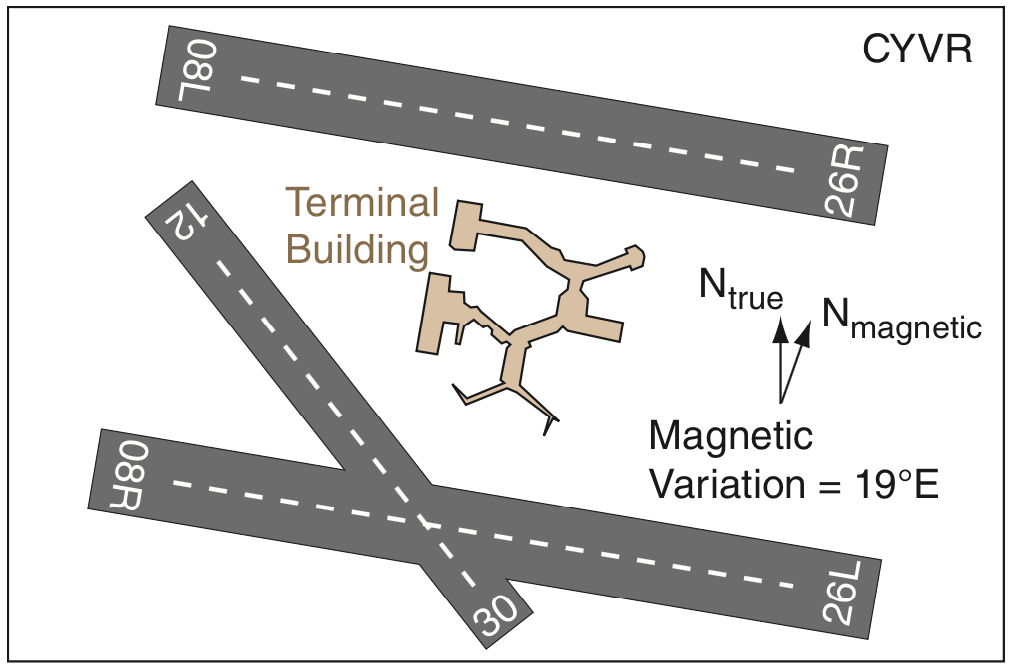
Sketch of the runways at Vancouver International Airport (CYVR). When two runways are parallel to each other, they are labeled with R or L for right or left.
Aircraft are designed to safely handle crosswind components up to a maximum certified value for takeoff and landing. In flight, there is no restriction. For some small aircraft, the maximum safe crosswind component for takeoff and landing is about 15 knots. Most medium and large airports have anemometers to measure wind speed, and wind vanes or equivalent to measure wind direction, and the pilot can use her radio to obtain this wind info before takeoff and landing. At smaller airports without weather instruments, sometimes a windsock (see image below) is used to give a rough indication of wind speed and direction.
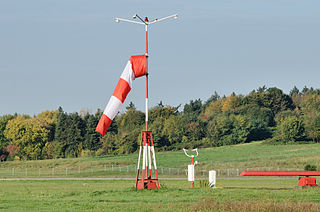
— Windsock. Wikimedia Commons.
If a pilot of a landing aircraft decides that it is not safe to land, the pilot flies a "go around" or does an "aborted landing" where they climb away from the runway before the wheels touch the runway, and then fly to some other airport where the runways are more closely aligned to the wind direction. To make matters even more difficult, often the air is very turbulent when the crosswinds are strong near the ground, making it even more difficult to land and take off.
Even large commercial aircraft are affected by crosswinds during
landing and takeoff. You can find some amazing YouTube videos (taken
with long telephoto lenses) at the web sites listed here.
- https://www.youtube.com/watch?v=bMUdXJPUwm8
- https://www.youtube.com/watch?v=7P9OAng32F0
- https://www.youtube.com/watch?v=UhO1BeC7m10
- https://www.youtube.com/watch?v=mMvLuUJFHYk
Examples of how to compute crosswind components
Example 1:
Suppose that the aircraft is pointing east (toward 90° compass heading). And suppose the wind is from the south (from 180° compass heading) at 30 knots. What are the headwind and crosswind components?
Here is a crude sketch of this situation: where ==>
represents your airplane, and -> represents the wind:
==>
^
|
Relative to the airplane that you are sitting in, the wind is coming
90° from your right. So there is zero headwind, but the crosswind
from the right is 30 knots. Does that make sense when using the
chart? Let's check:
Using the HINT, the chart should be rotated to look as shown
below. Namely, if east is to the right, and south is down, then
the chart has the "headwind" axis pointing toward the right (namely,
the direction towards-which the aircraft is pointing), and the
"crosswind" axis pointing toward down (for a wind from the
south).
A wind of 30 knots (the white curved arc corresponding to 30 knots)
from the south (the white straight line labeled 90 degrees) is at the
yellow point in the
graph below, relative to the aircraft which is at the "0" point in this
graph (now in the upper left corner). According to the graph,
there is indeed zero headwind component, and 30 knots of crosswind
component.
Example 2:
Suppose that, relative to the direction you are facing, the wind is coming from the right at 60° at speed 23 kilometers per hour (km/h). Find the headwind and crosswind components.
Method: On the crosswind graph (see example below), find the diagonal line for 60°. Where that line crosses the curved line for 23 km/h, draw a dot "o" or "X" on the graph. The graph above does not have a curved line for 23 (km/h), so you need to interpolate between the curved lines for 20 and 30 km/h. Namely, 23 km/h is 3/10 of the way from the 20 line to the 30 line.
When I did that, I found the point drawn on the graph below (I drew a yellow dot). This point represents the total actual wind.
Next, draw a vertical line from your point down to the bottom axis, and read off the crosswind component. When I did that, I get a 20 km/h crosswind for this example.
Finally, draw a horizontal line from your point over to the left axis, and read off the headwind component. When I did that, I get about a 11 km/h headwind for this example.
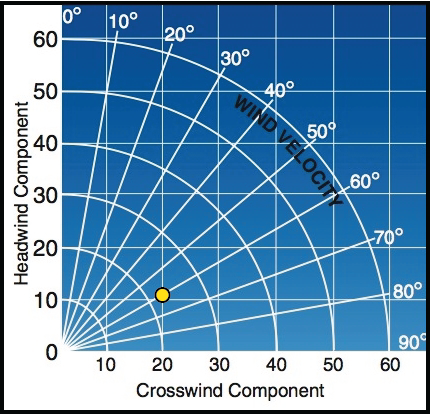
— Source: FAA Safety, modified by Stull.
Example 3:
Suppose you are flying from Vancouver to Dawson Creek, BC, as sketched by the maroon line showing the "desired flight track" in the diagram below. This desired flight track is 15° to the right of North, for this example. Also suppose that the winds are from the northeast at 20 knots (blue arrows in the diagram below). What are the headwind and crosswind components?
Method: A wind from the northeast means the wind is coming from a 45° angle relative to north. But that is NOT the angle RELATIVE to the desired flight track. The flight track in this example is roughy 15° relative to north. Thus, the wind angle RELATIVE to the flight track is 45° – 15° = 30°.
Next, plot a point (the yellow dot in the bottom figure) corresponding to a direction of 30° and a wind speed of 20 knots. The green dashed line indicates a crosswind of about 10 knots. The brown dashed line indicates a headwind of about 17 or 18 knots.
Some web sites can compute the headwind and crosswind components for you:
Summary
On take-off and landing, headwinds are good because they allow you to use a shorter runway. In flight, headwinds are bad because they slow you down and require that you use more fuel to get to your destination. Conversely, tailwinds are bad on take-off and landing, but are good in flight.
Regardless of the ultimate direction pilots want to fly to their
destination, they always try to pick a runway direction that would have
a headwind, even if the runway is not pointed in the direction they
ultimately want to go. After take-off with the nice headwind,
then they turn to the desired heading toward their destination.
On take-off and landing, crosswinds are difficult, so all aircraft have a "max allowed crosswind" speed that is indicated in the pilots operation handbook (i.e., the instruction manual). Different aircraft have different max crosswind speeds, but for many general aviation (small) airplanes, that max crosswind component is roughly 15 knots.
Because of the crosswind difficulty in take-off and landing, and
because of the headwind advantage, many airports have multiple runways
in different directions. Thus, for any wind direction, hopefully
one of the runways is aligned close enough to the wind direction to
have a good headwind and minimal crosswind.
In flight, crosswinds are not a difficulty. They do require the pilot to aim the aircraft in a direction to compensate for the crosswind, but pilots are trained to do this. The crosswinds result in a slightly slower speed over the ground, causing you to use a bit more fuel and take a bit more time to reach your destination.
Bottom line: headwind-, tailwind-, and crosswind-components do
affect flight and flight safety, and you can estimate these components
using the graphs provided above. If you have a question on an
exam requiring determination of these components, we would provide the
headwind-crosswind graph with the exam.
Key words: headwind, tailwind, crosswind, headwind
component, crosswind component, windsock, go around
Extra info for experts; not needed for this course.
Image credits. Crosswind graphs from the FAA and from Transport Canada. Aircraft drawing from the FAA. Map by Google.
The windsock photo, available on Wikipedia commons, was taken by Wladyslaw (Taxiarchos228) with support from the Community Budget of Wikipedia Germany. Other graphics features added by R. Stull.
